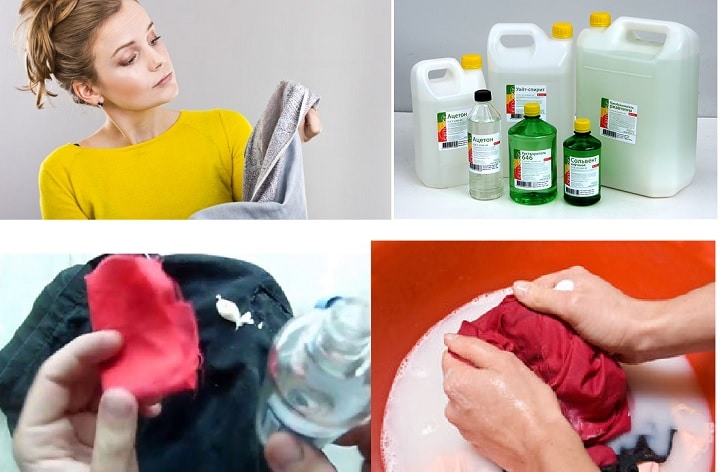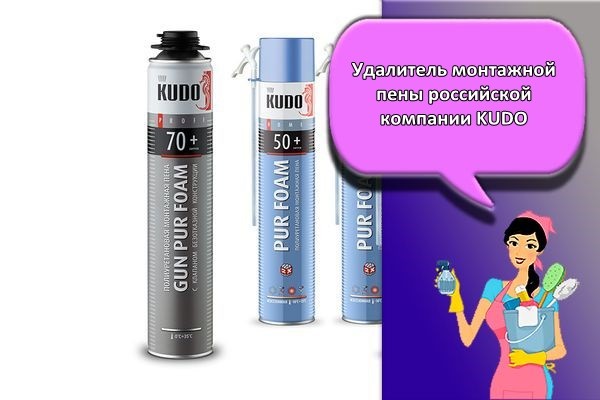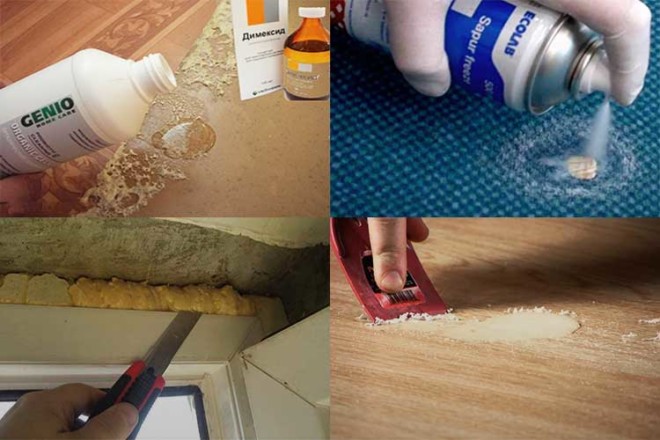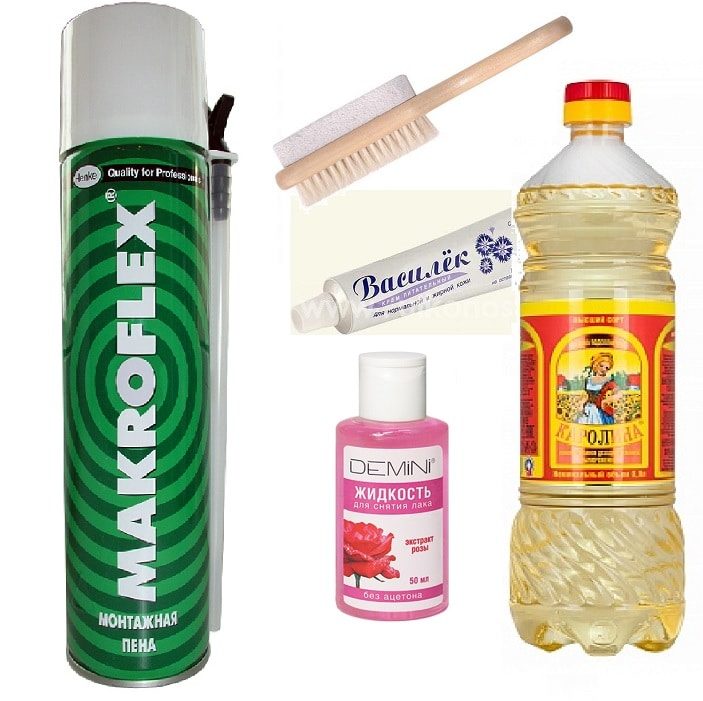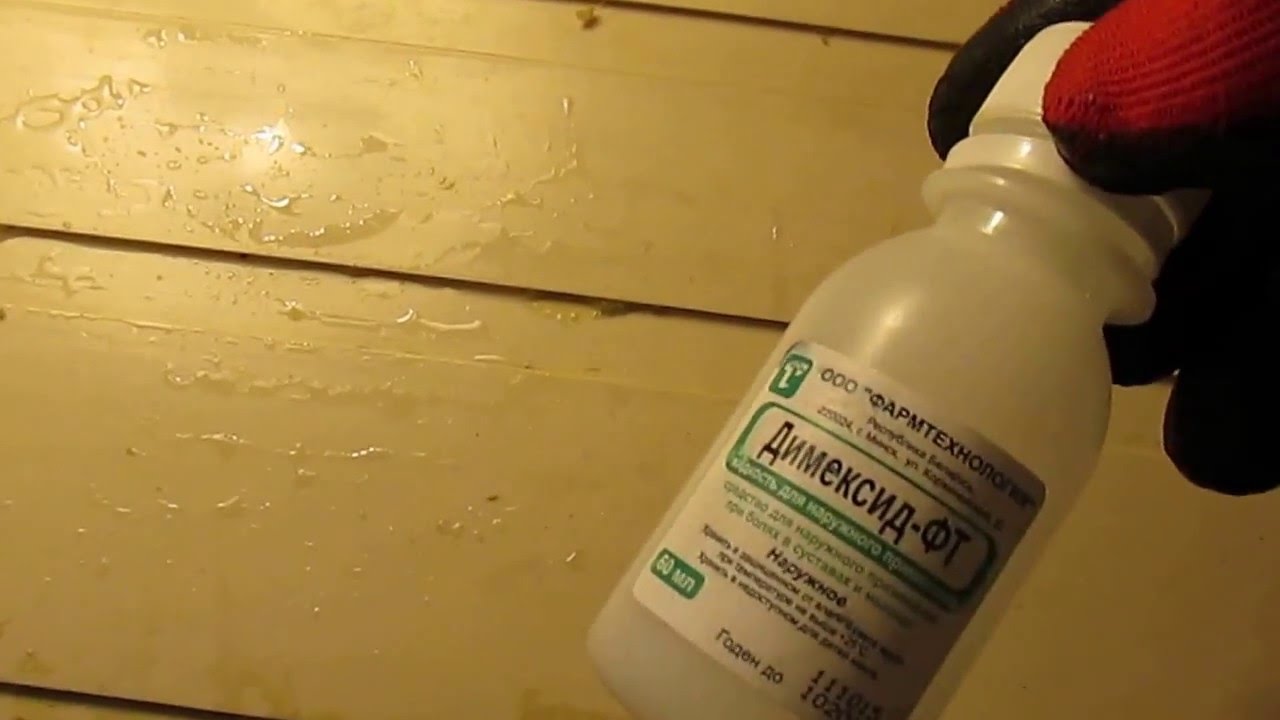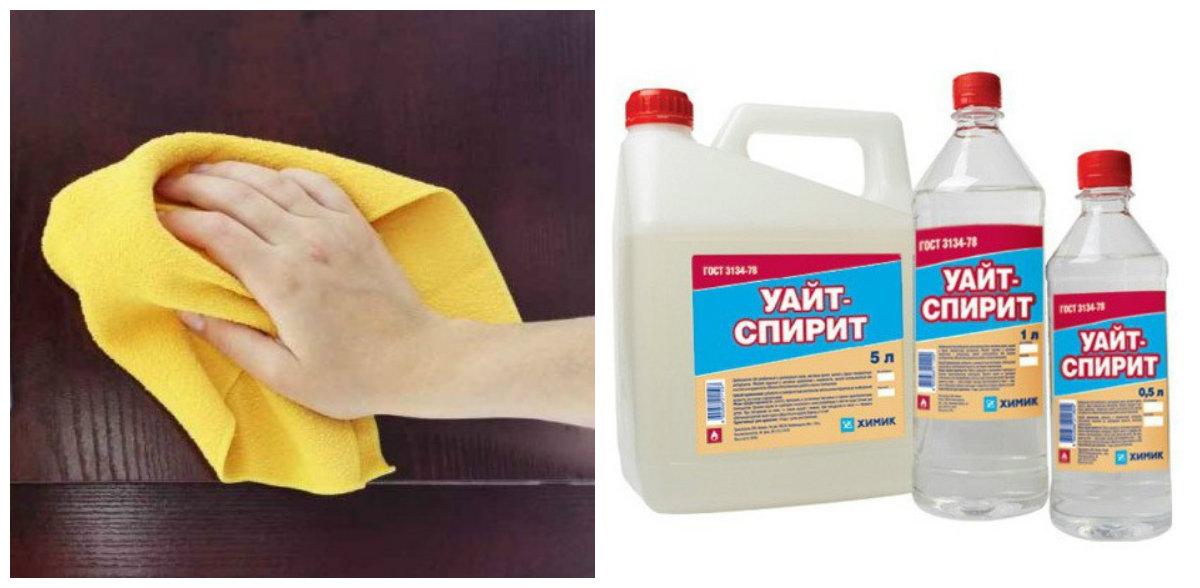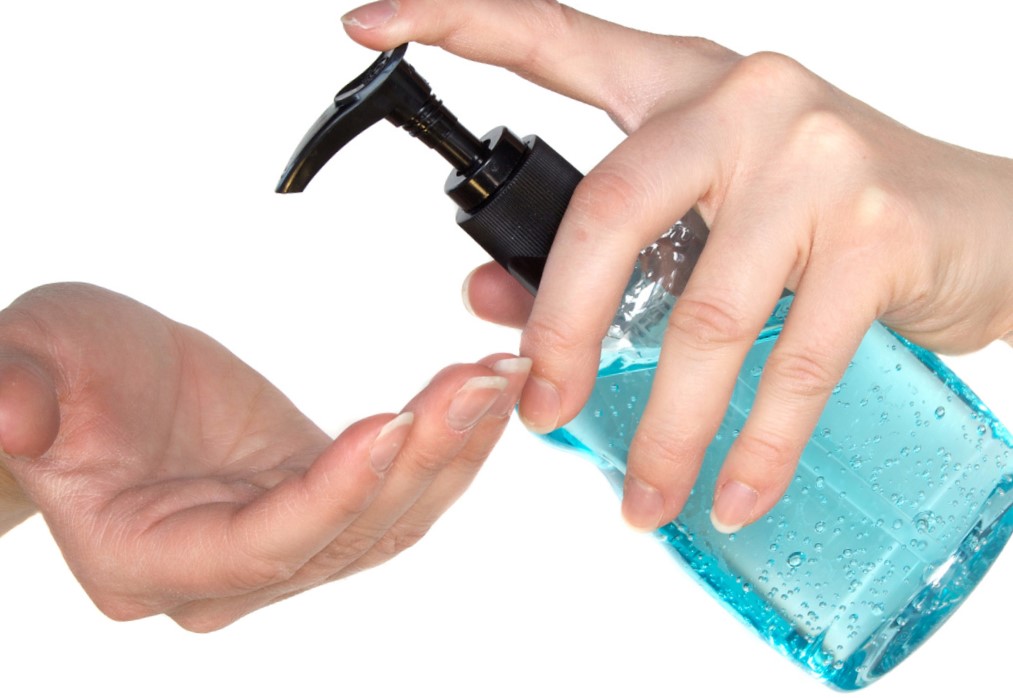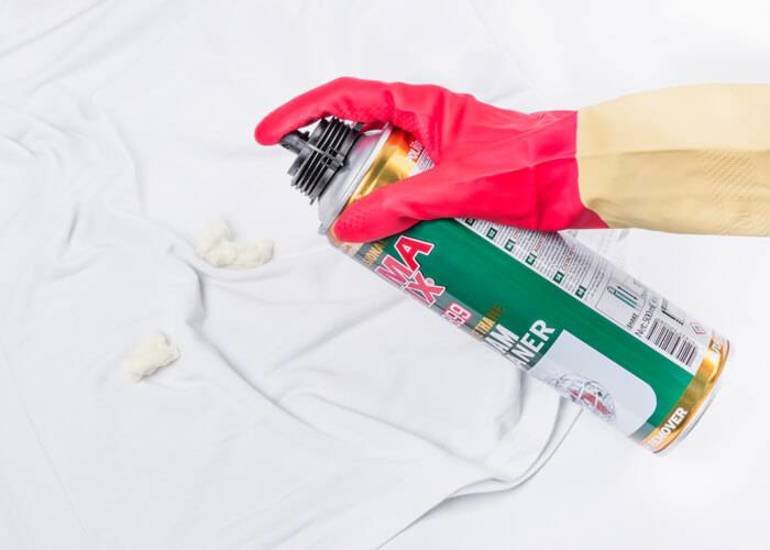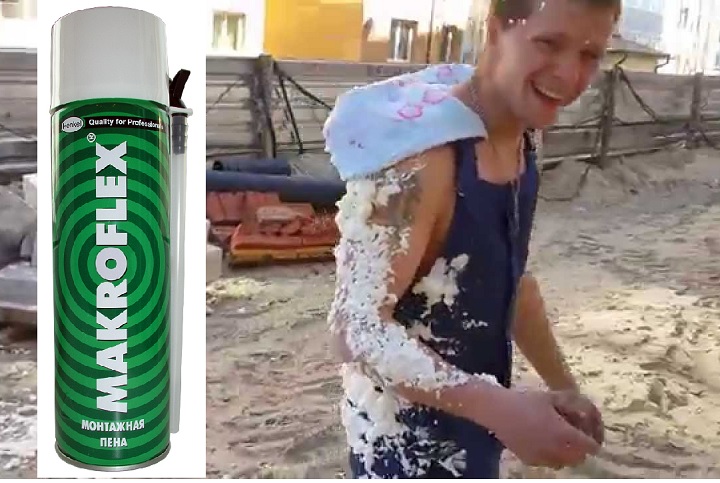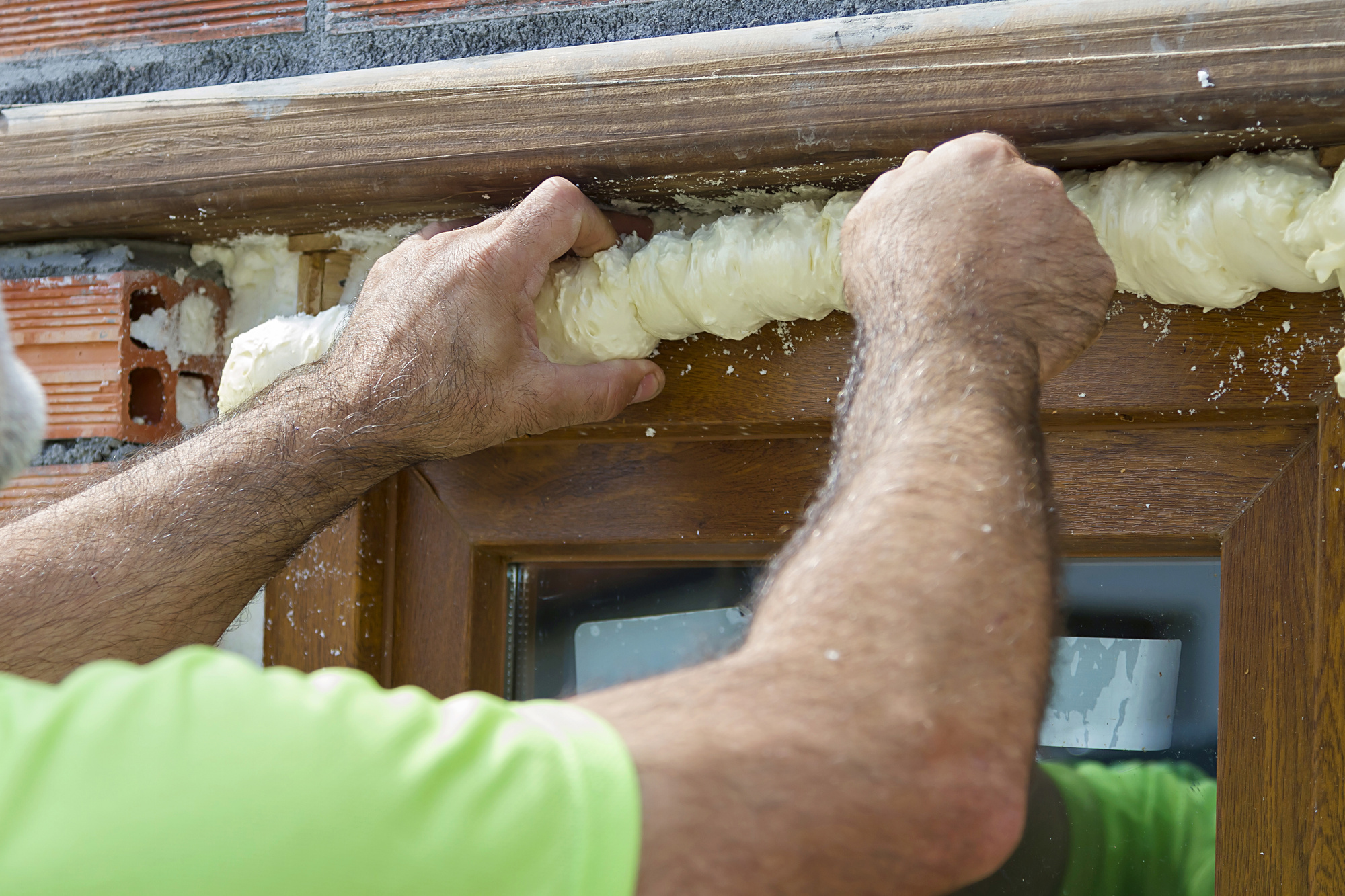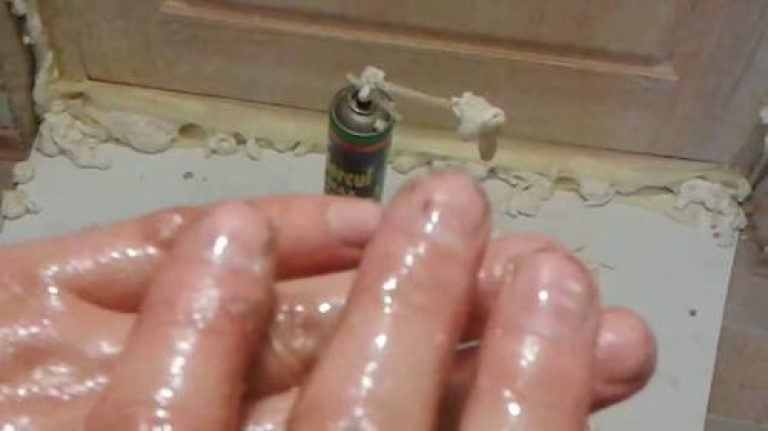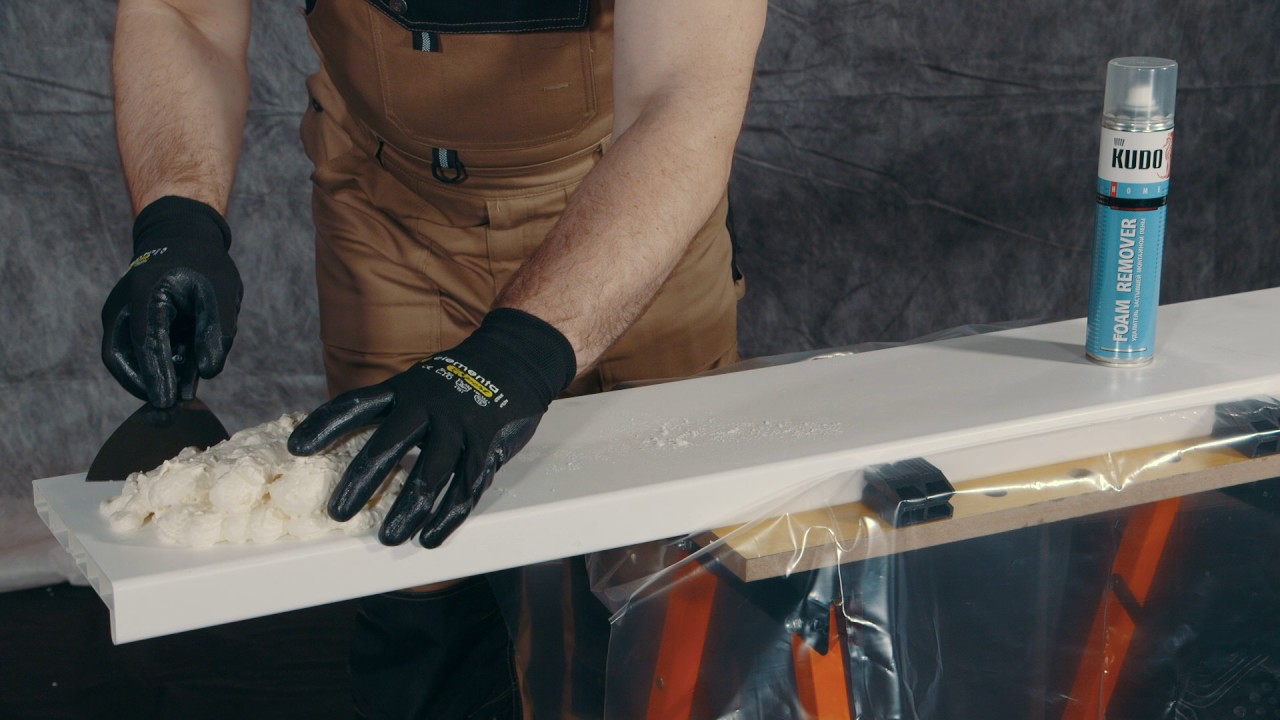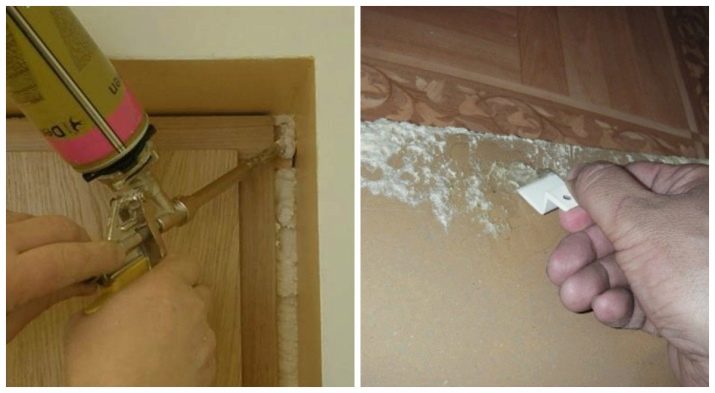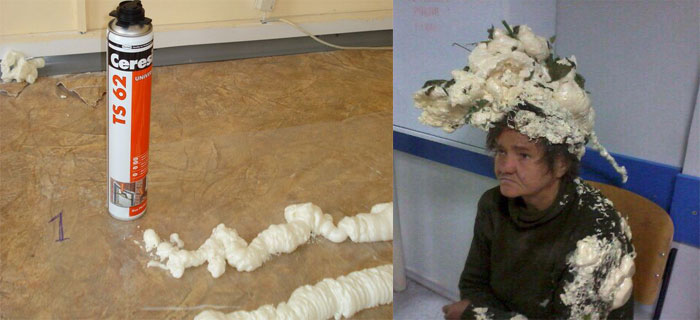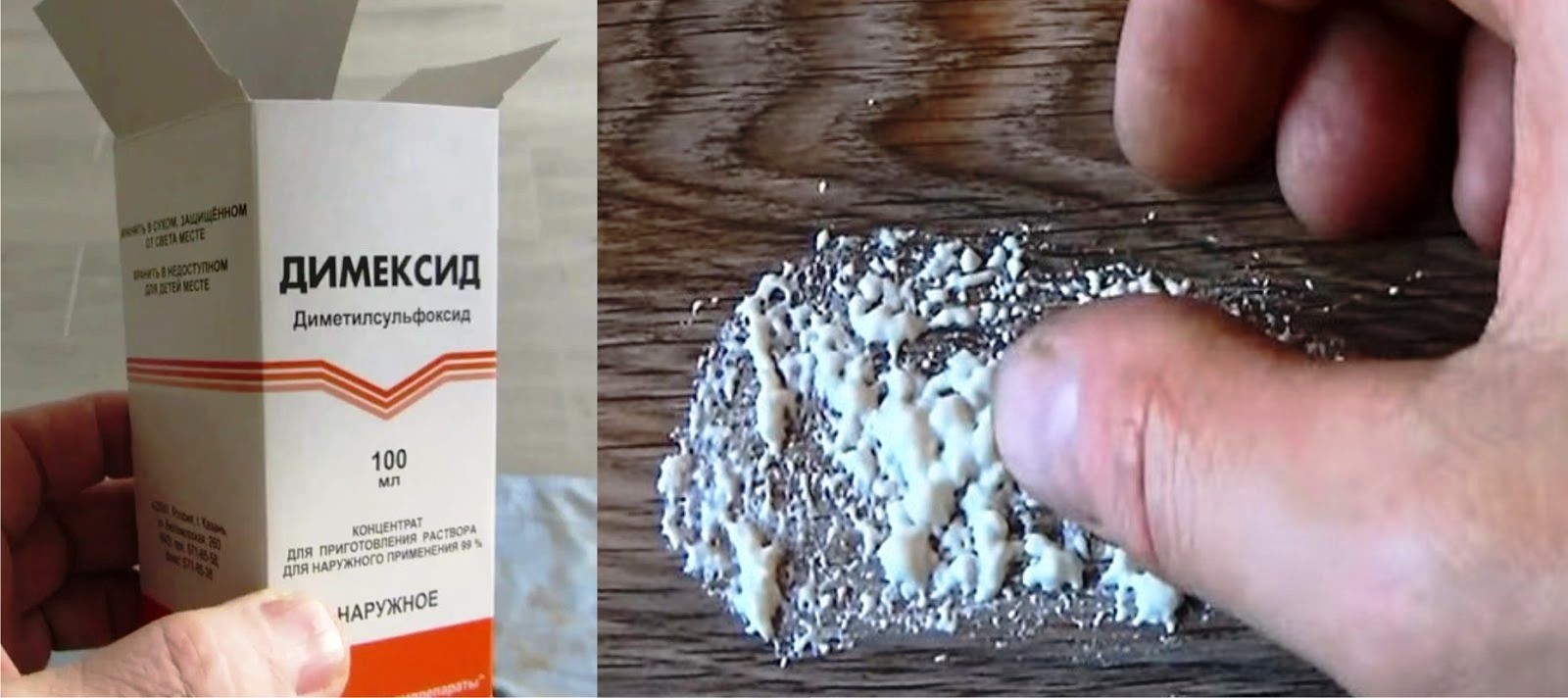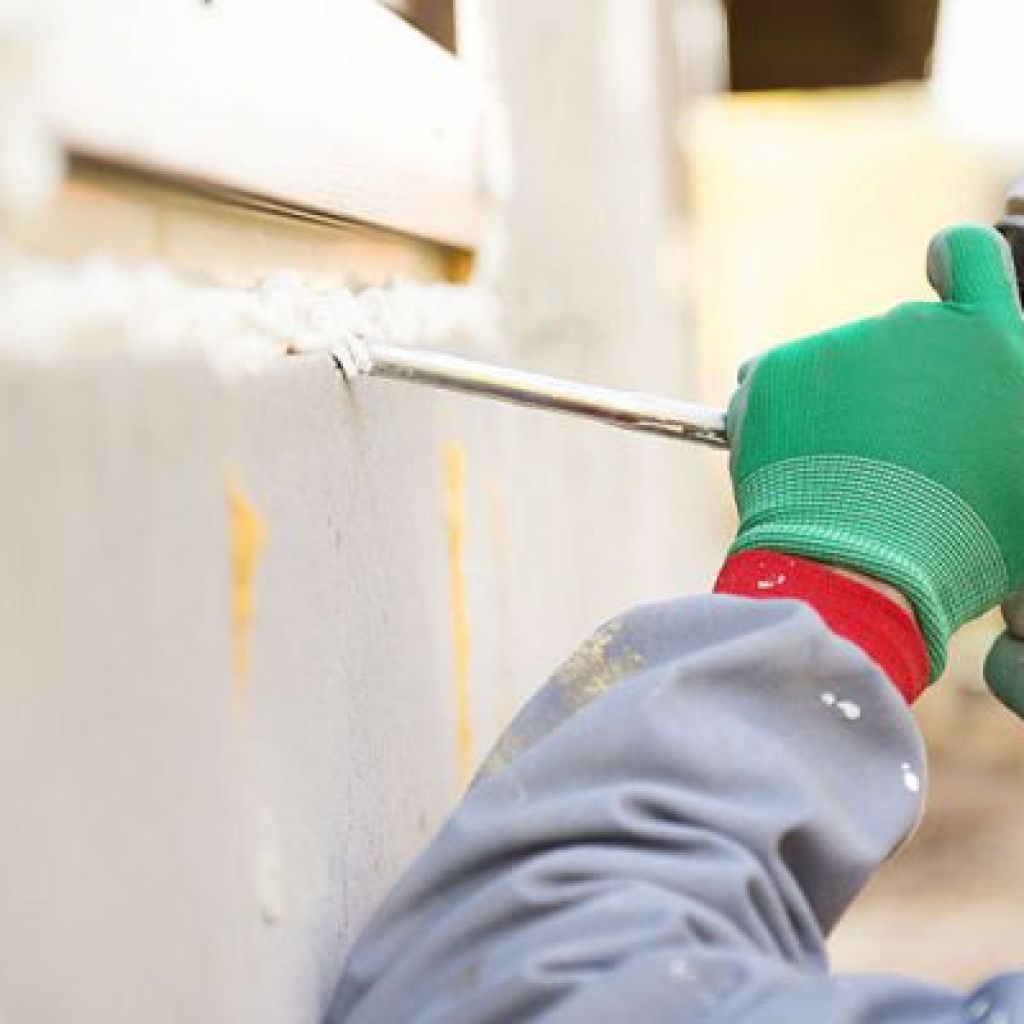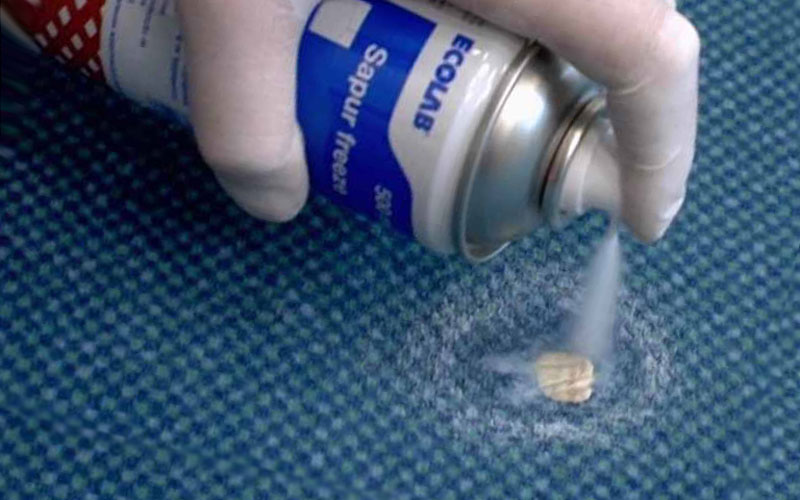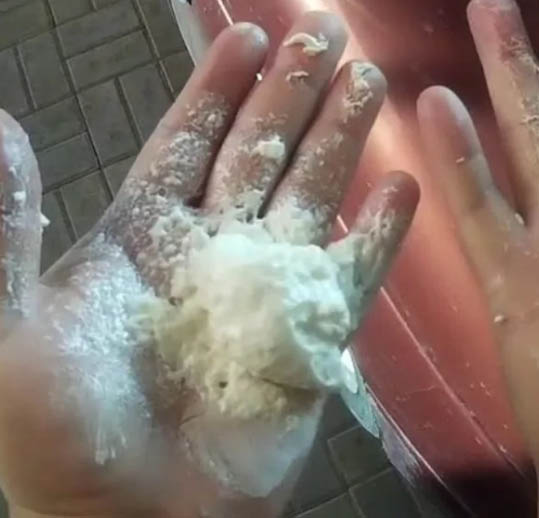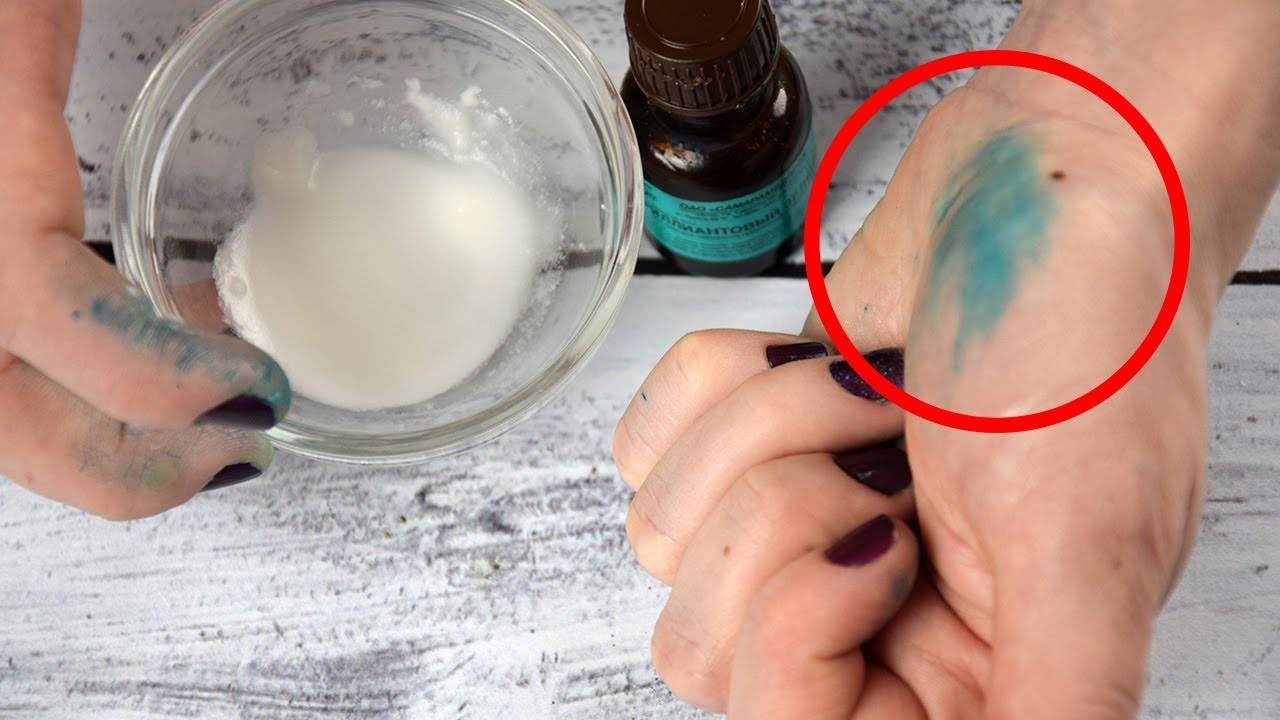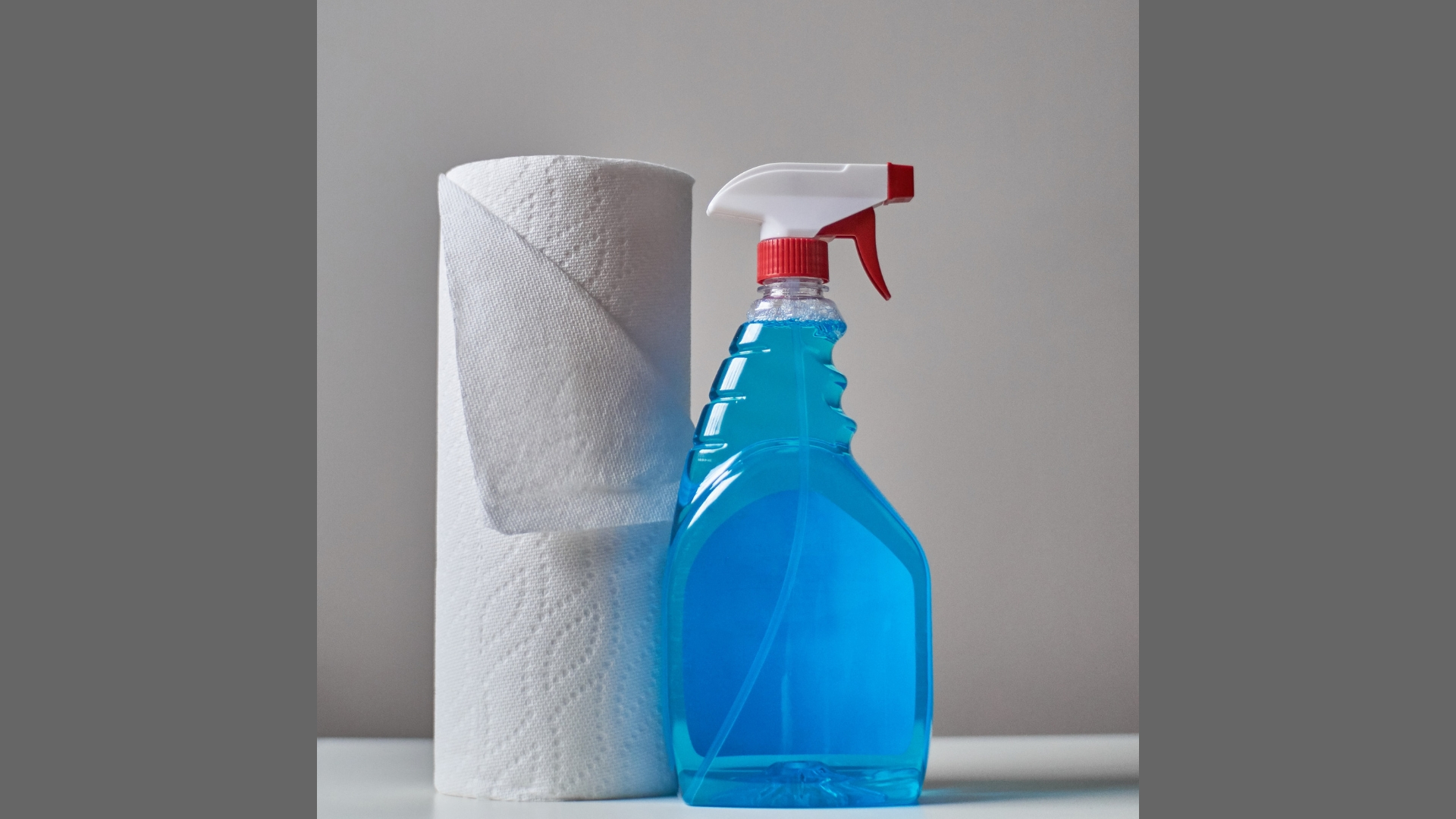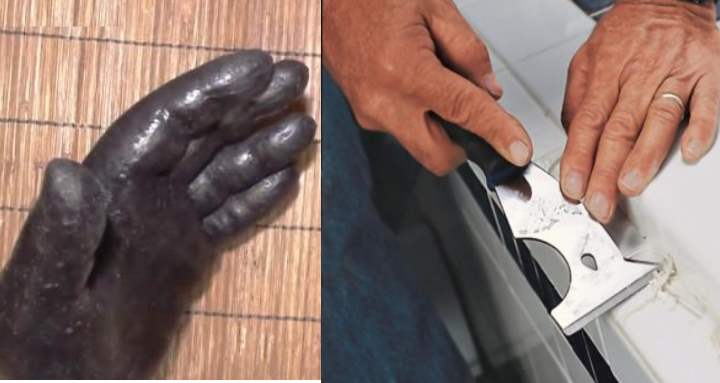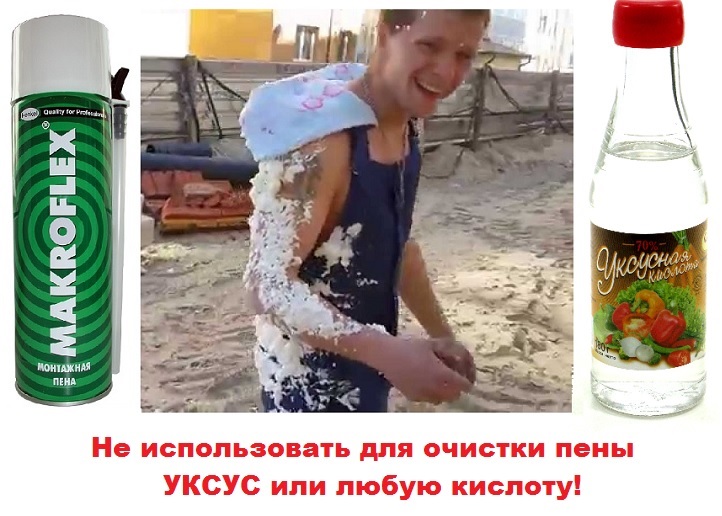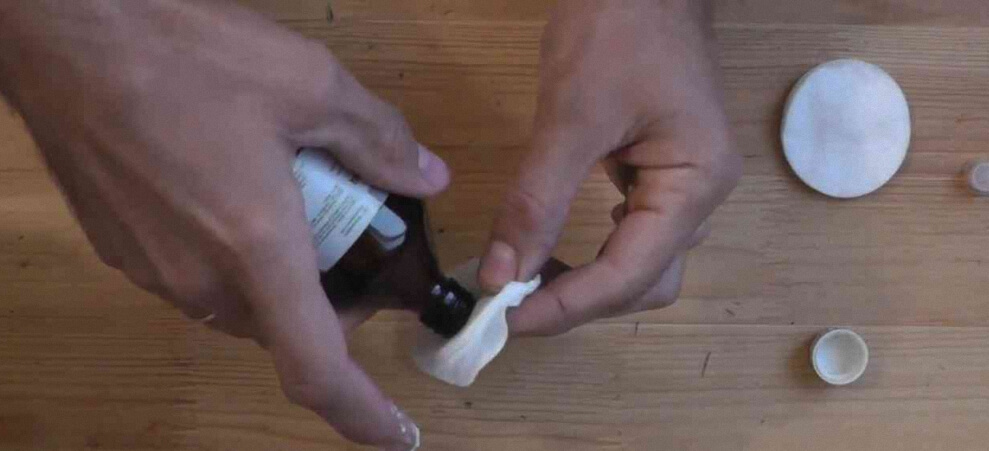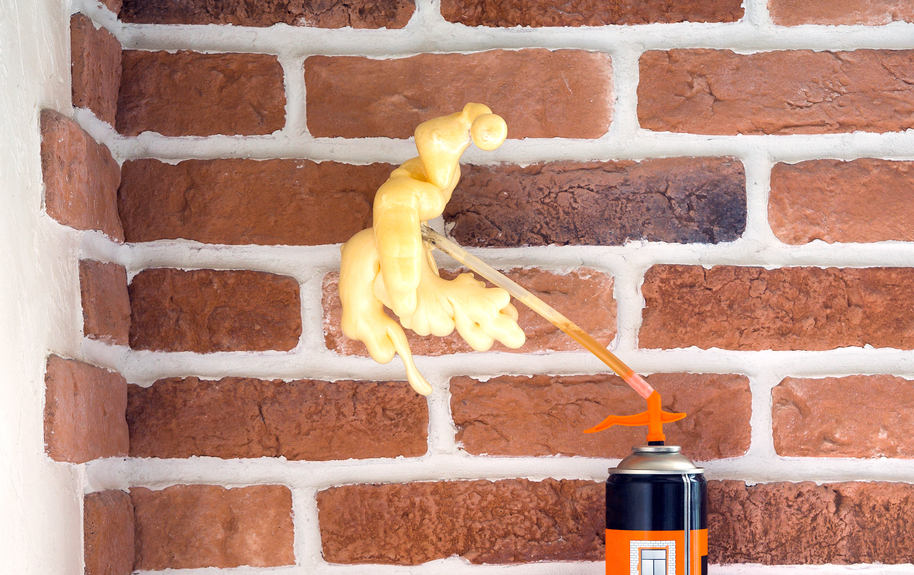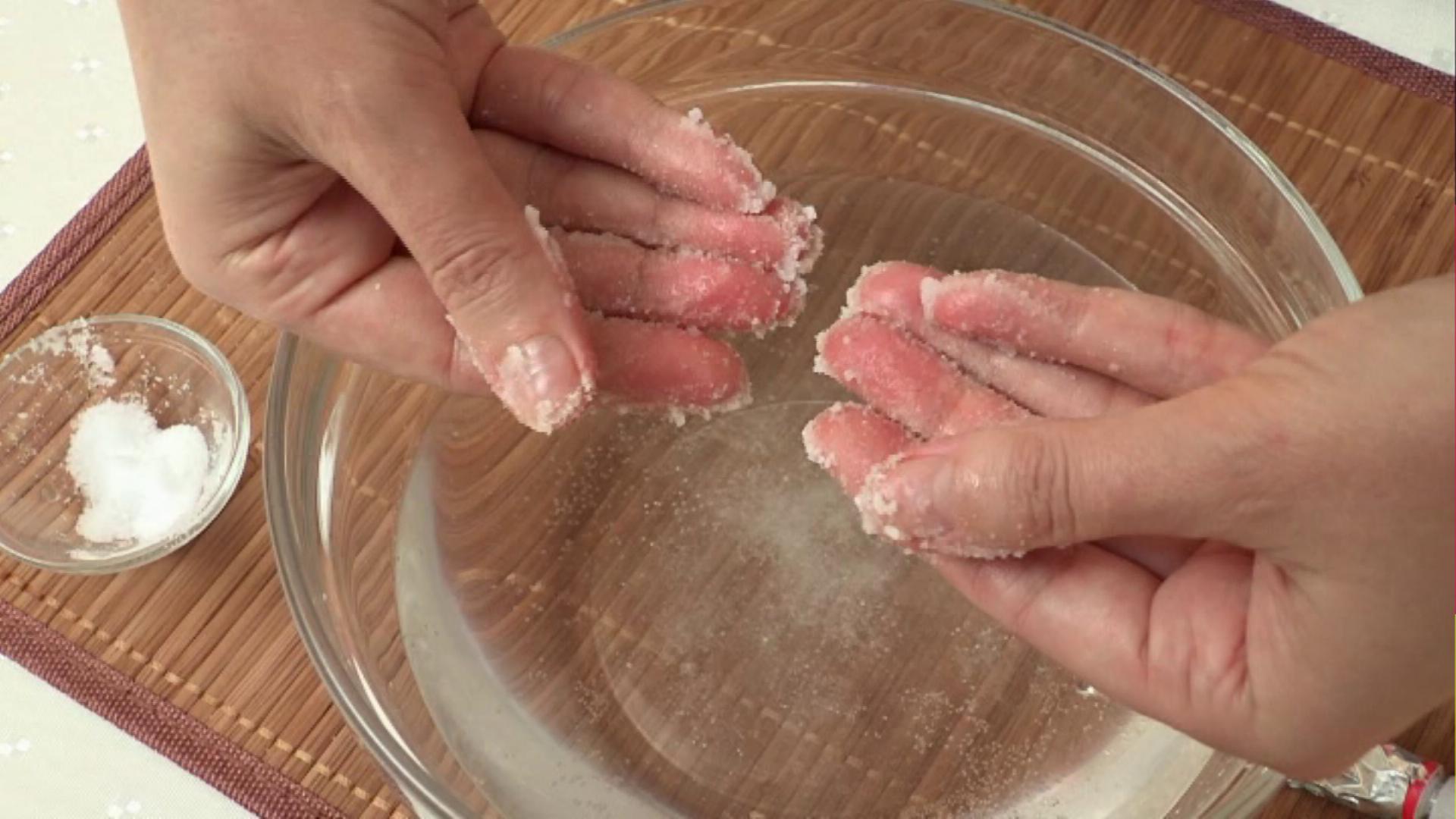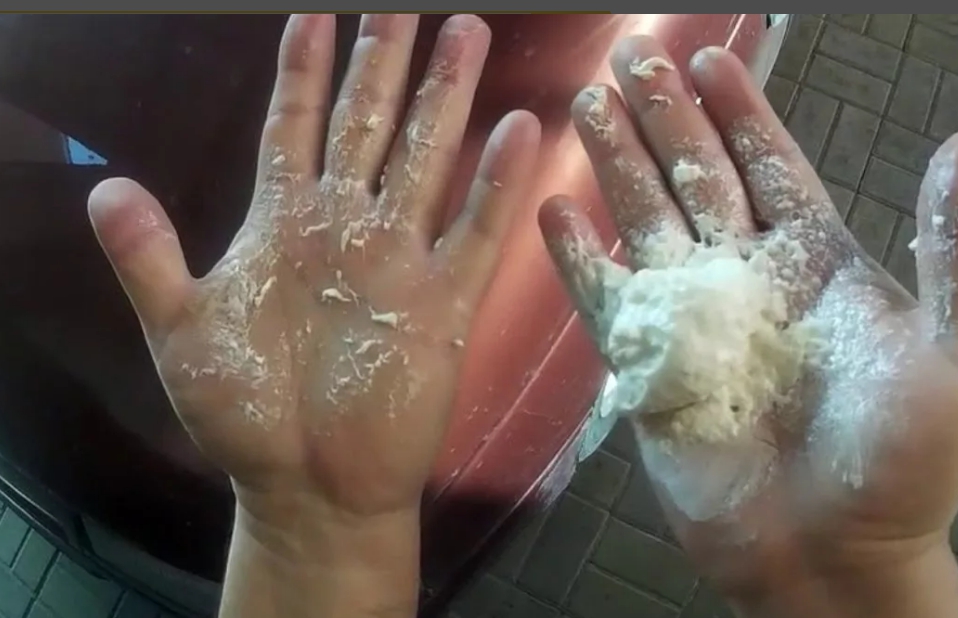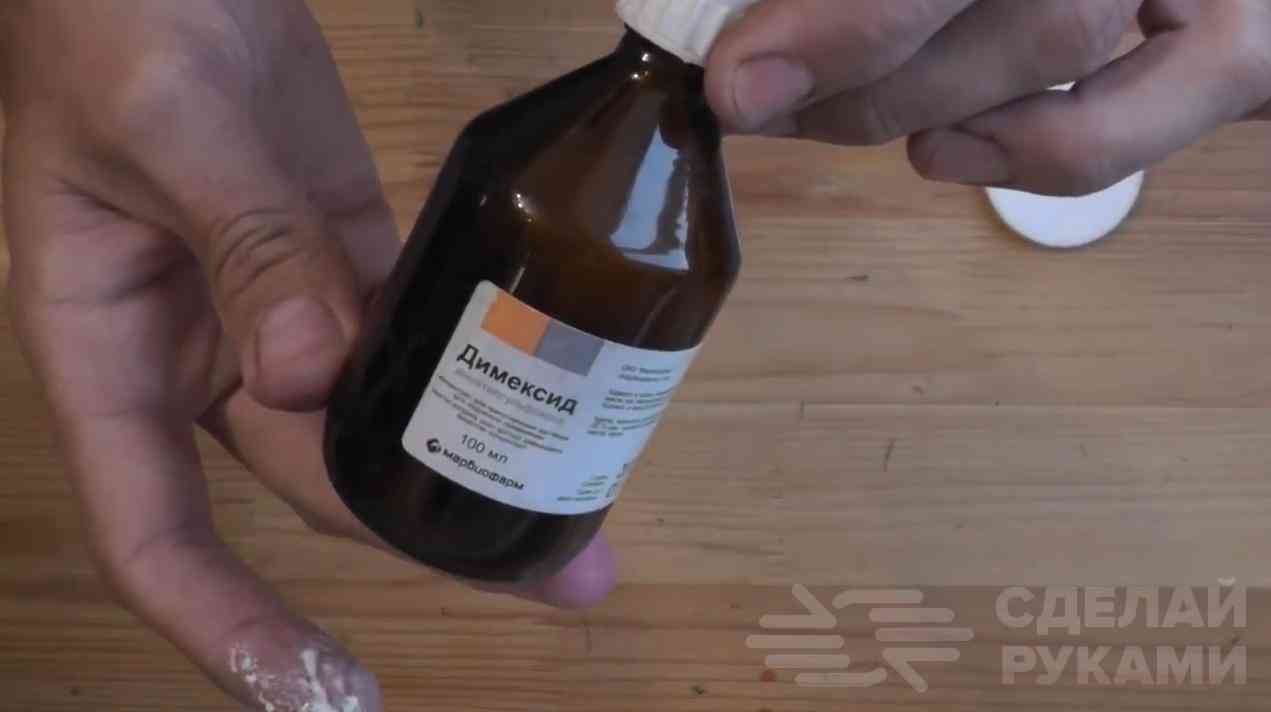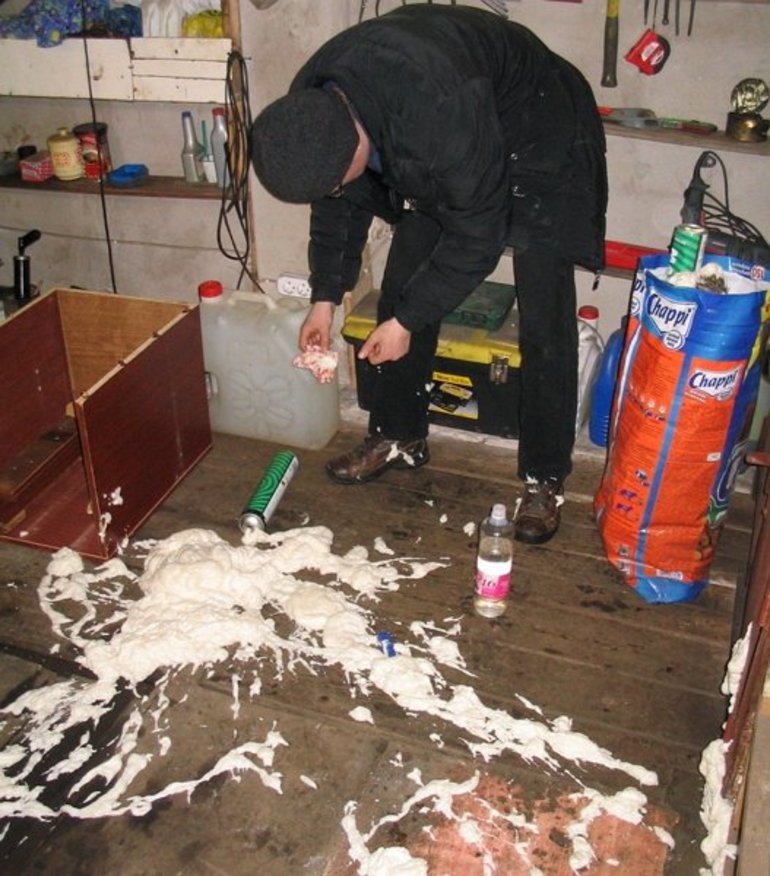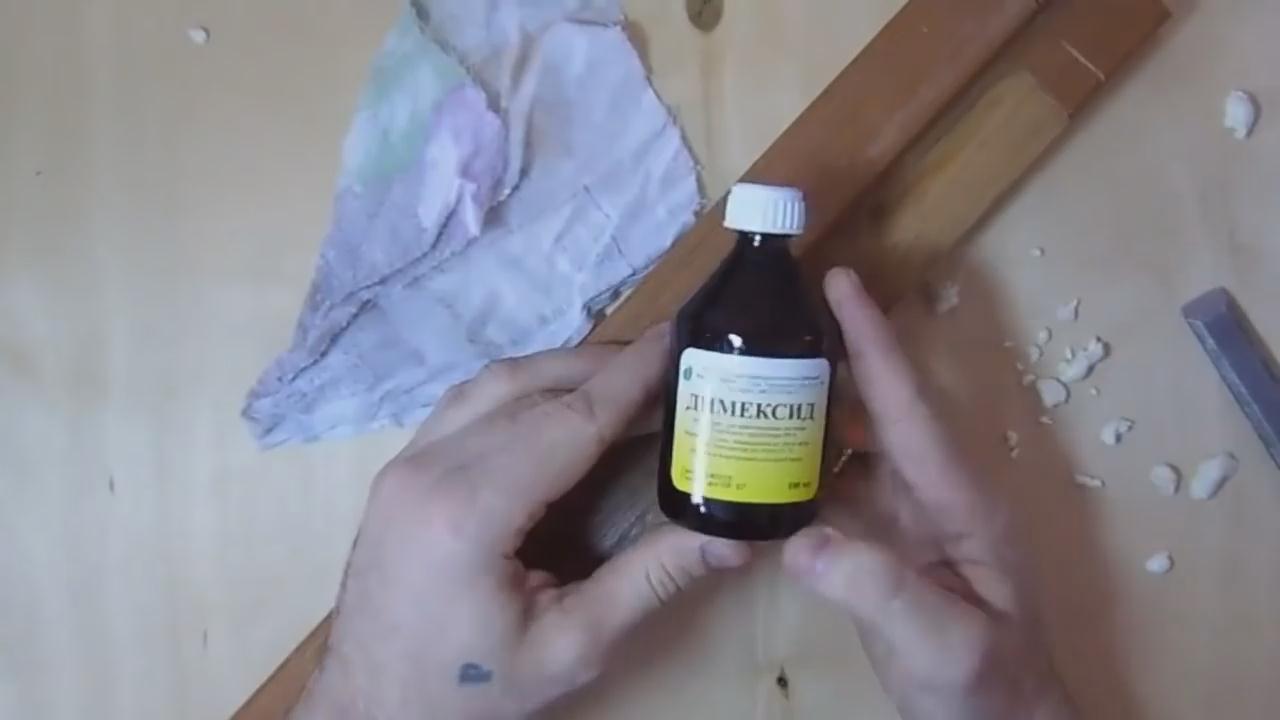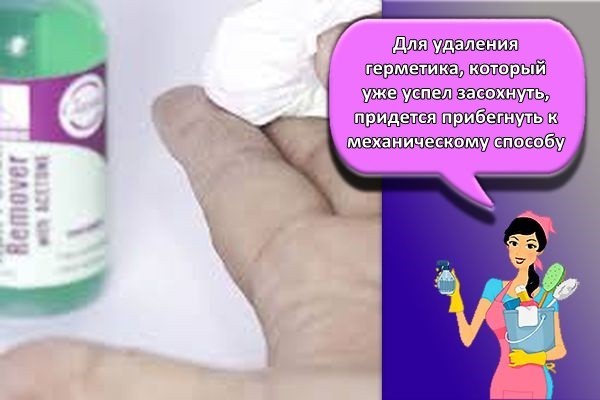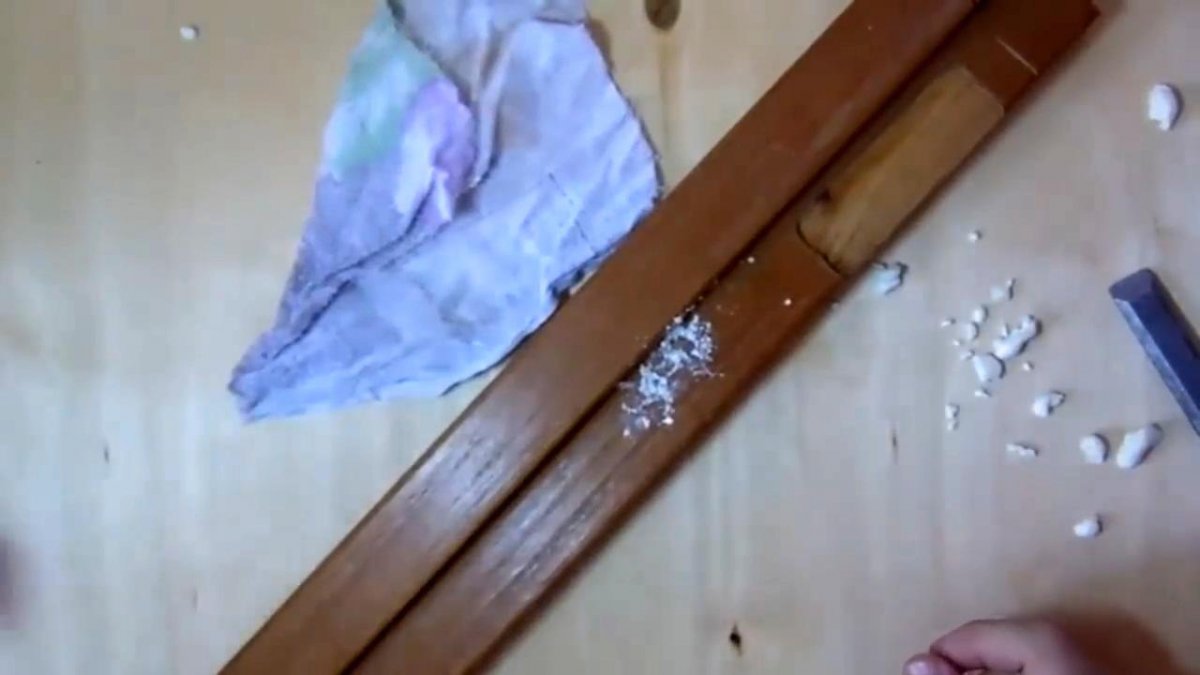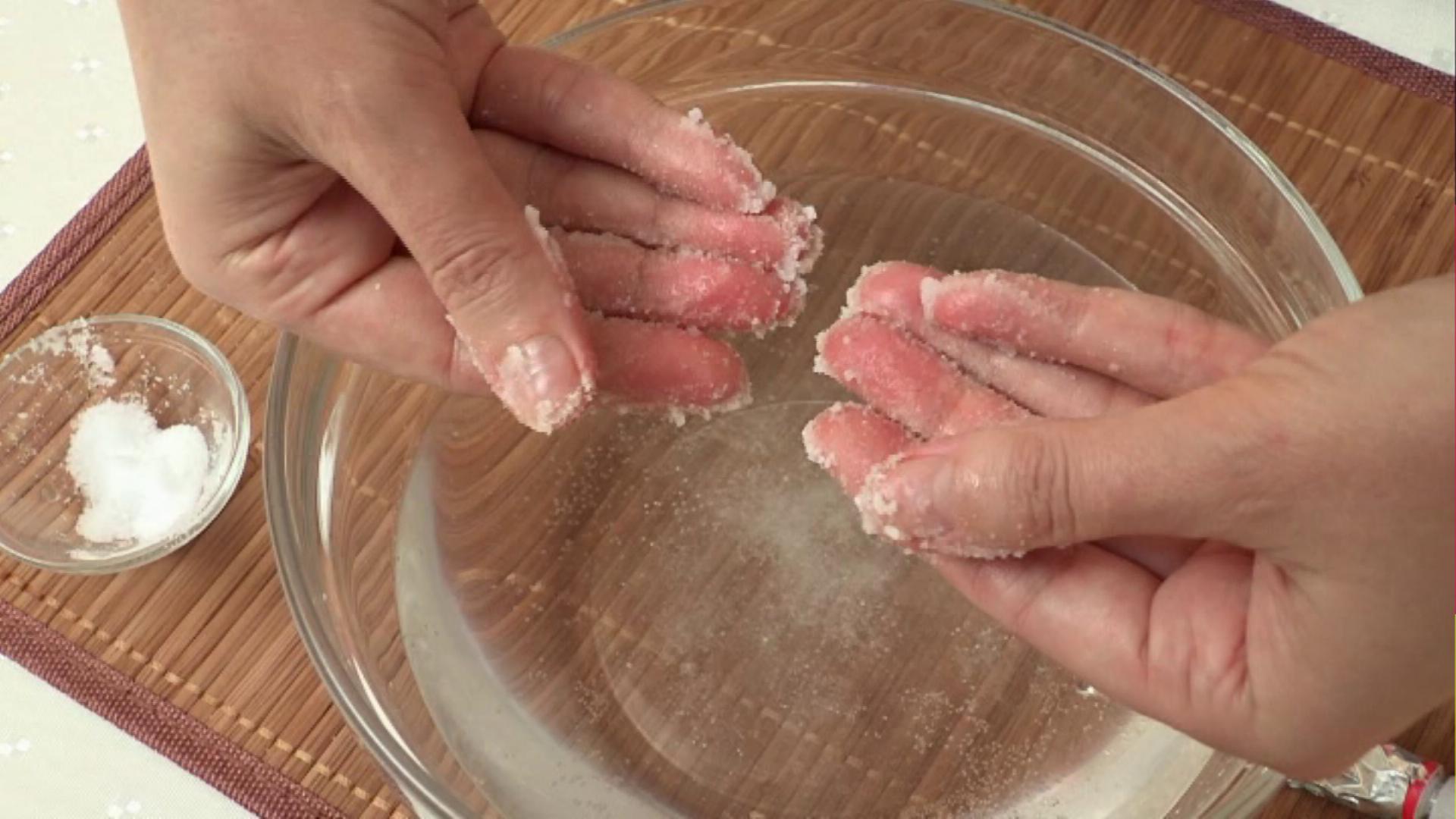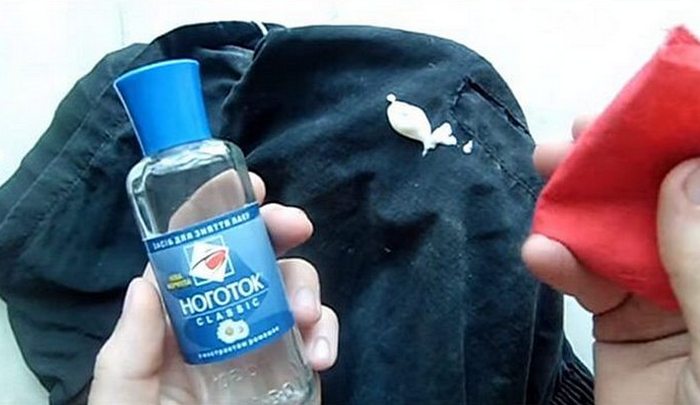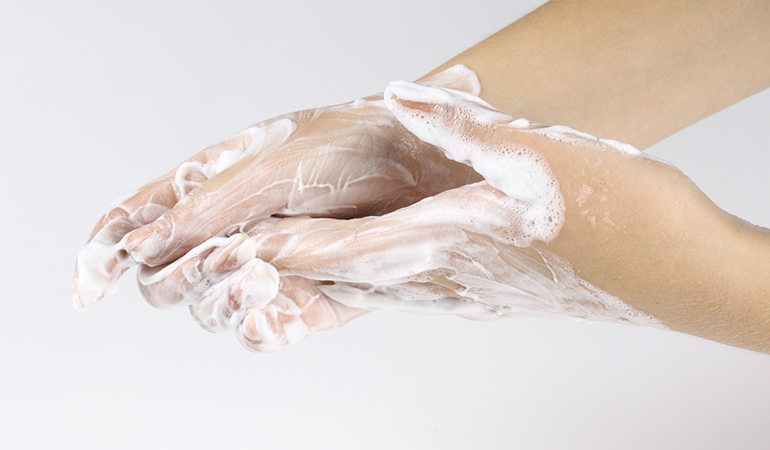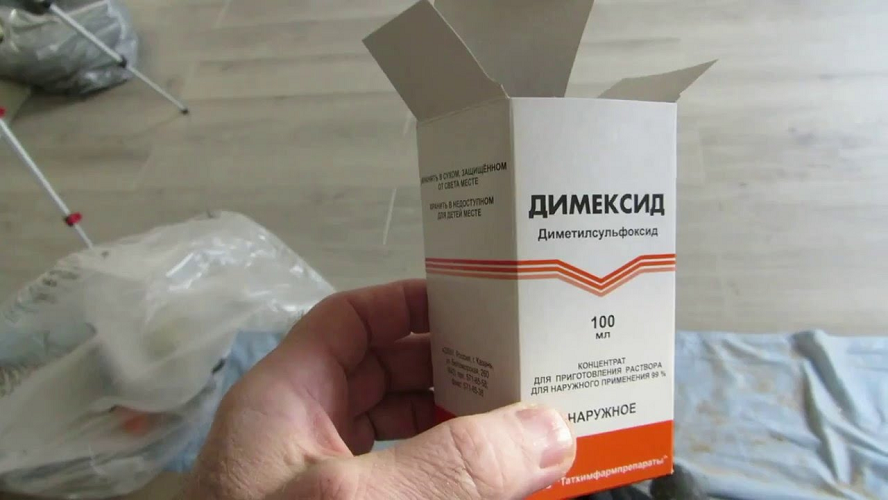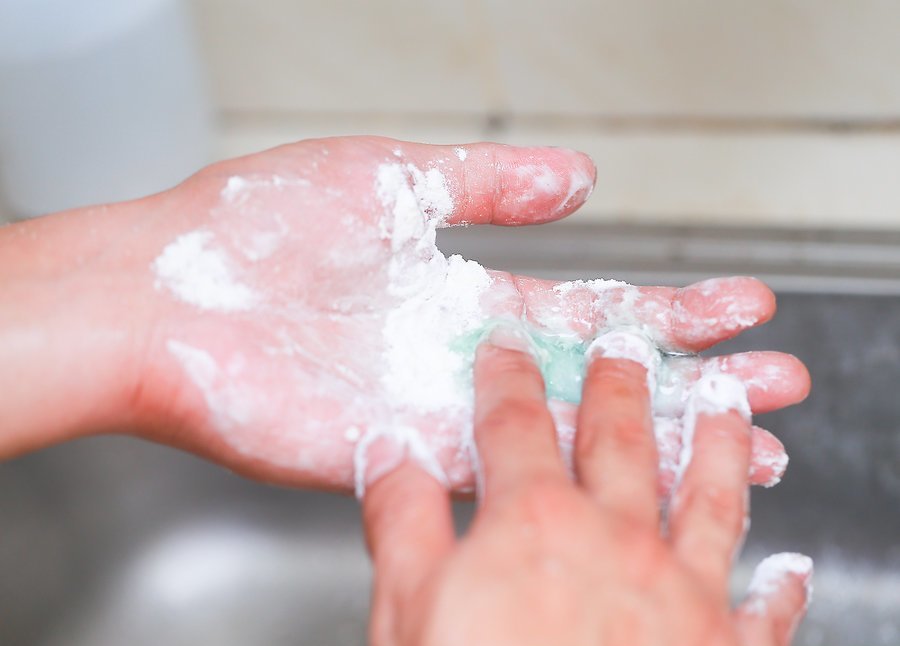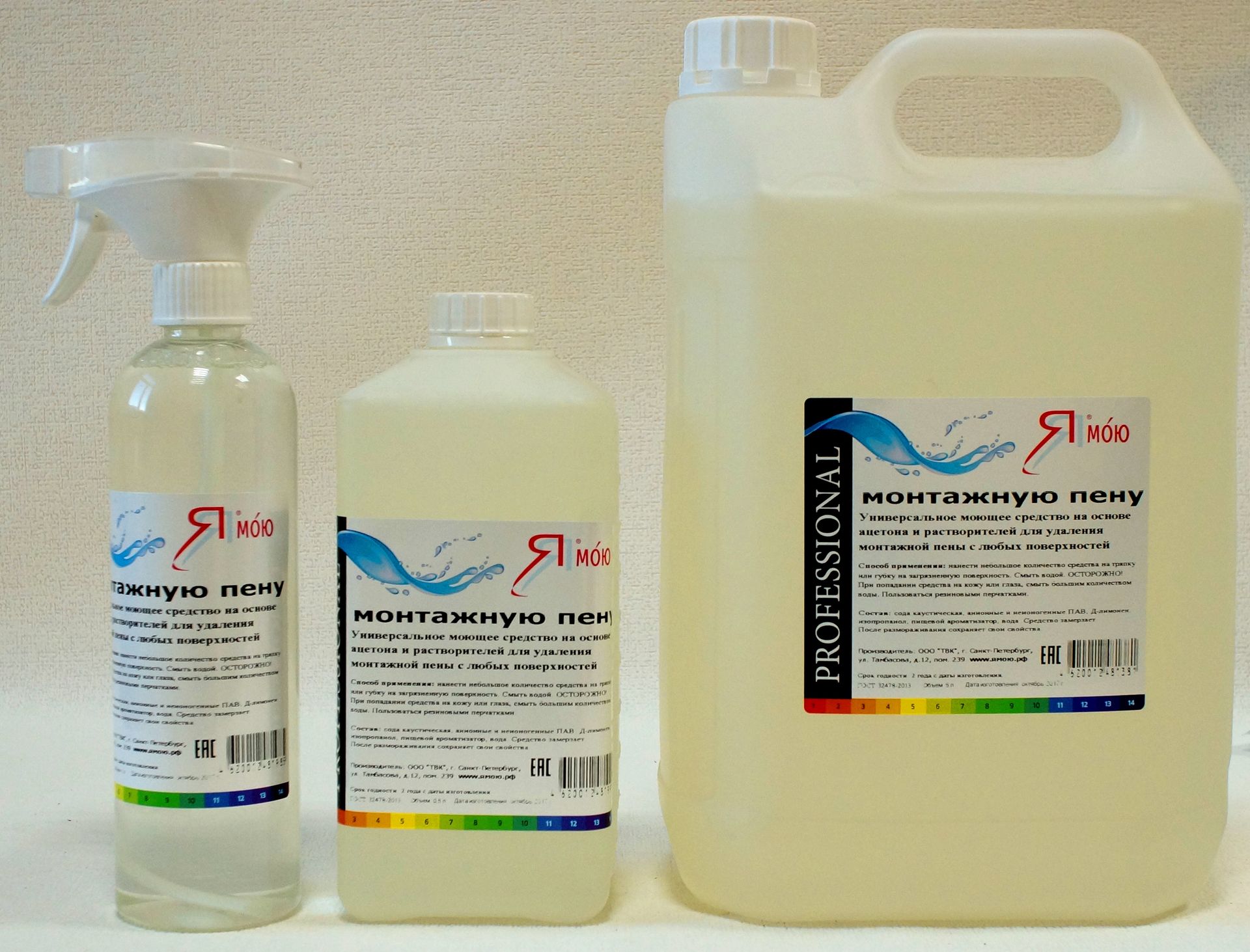Methods for removing cured foam
If it was not possible to get rid of the liquid product, and the stains went unnoticed, you will have to use more effective methods for cleaning the skin of your hands.
Special aerosols
Many manufacturers of sealants or paints and varnishes produce special cleaners in aerosol form. You can buy a can with foam so you don't have problems with cleaning your hands or other surfaces. Also, using aerosol solvents, it will be possible to remove the polyurethane foam from the gun, on which the sealant gets even more often. It is better to buy an aerosol of the same brand with foam - the cleaning efficiency will be higher.
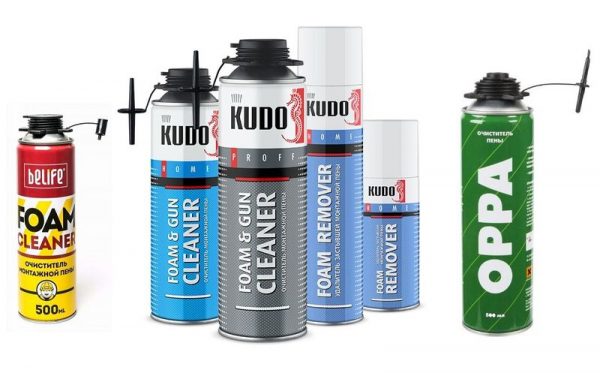
Liquid solvents
Use organic solvents with care. They do not cause burns, but they dry the skin a lot, so contact with hands or other areas should be as short as possible.
After cleansing the skin, wash your hands with soap and apply a nourishing cream.
Kerosene, gasoline, acetone and white spirit
Any organic solvent can remove a sealant stain, because most assembly tools contain such substances in the composition and harden only after they evaporate. It is best to use acetone or nail polish remover - they are most gentle on the skin.
Stubborn stains should be removed with gasoline, kerosene, moistened with a cloth and applied to your hand for 5-10 minutes. After softening, you need to wash the composition, if necessary, using a body scrub. All solvents give off an unpleasant odor, their vapors are harmful to health, so you need to work with them in a well-ventilated area.
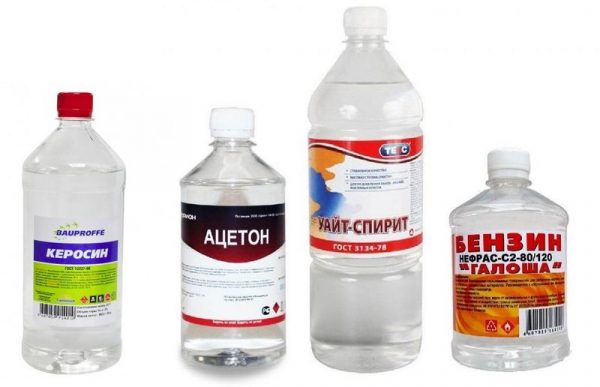
Folk methods
Unconventional methods of cleaning hands from polyurethane foam are used when there are no solvents available. Those of them that involve the use of food are the safest, even suitable for children and allergy sufferers.
Vegetable oil
Before use, the vegetable oil must be warmed up so that it becomes warm (about +40 degrees). Then apply to a cotton circle or a bandage folded in three, apply to the contaminated area of the skin. After 10 minutes, the sealant will soften and can be wiped off mechanically or washed off with plain water and soap. To be sure to get rid of the stain, you can rub your hands with dishwashing liquid after the oil.

Salt
Salt is an excellent abrasive that quickly cleans the skin of any impurities. A small stain can simply be wiped off with salt using vigorous movements. If the polyurethane foam has eaten in and is not removed, the actions should be as follows:
- take a liter of hot water;
- add a tablespoon of salt, dissolve it;
- place your hand in the solution, hold for a couple of minutes before steaming the skin;
- remove the stain with coarse salt or a scrub.
"Dimexid"
This drug is sold in any pharmacy and is inexpensive. It perfectly removes dirt from sealant, paint, and other building compounds
It is only important not to use "Dimexide" undiluted, as it can cause burns. It is necessary to add water to the product in a 1: 1 ratio, then wipe your hands with a cotton swab, cloth
If there are signs of an allergic reaction, the skin should be washed immediately with soap and water.

Mechanical cleaning can damage the skin if not done carefully. Therefore, it is advisable to use any abrasives (scrub, salt), brushes and pumice after preliminary steaming of the hands. It is enough to hold them in hot water for 5 minutes - in a bath, under a tap. After that, the skin should be lubricated with a fat cream, oil, then proceed to rubbing off the stain. Another safe way to clean your hands is to use an abrasive on soapy skin.Do not use a knife, scissors, metal scrapers - this is fraught with injury and infection!
How to wash hands with solvent and acetone?
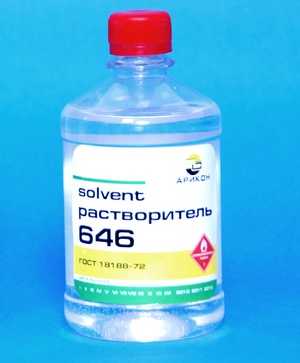 One of the most effective hand cleaning products is a special solvent. It is best to choose an aerosol of the same brand as the foam itself. In addition to cleaning hands from building materials, it has the ability to clean guns for applying sealant to a door or other surface to be treated. The solvent is also suitable for other needs:
One of the most effective hand cleaning products is a special solvent. It is best to choose an aerosol of the same brand as the foam itself. In addition to cleaning hands from building materials, it has the ability to clean guns for applying sealant to a door or other surface to be treated. The solvent is also suitable for other needs:
- it can be used to clean upholstered furniture;
- suitable for cleaning carpets at home;
- cleaning other surfaces.
In order to use it to wipe your hands, you first need to spray it on the skin, and then rinse with plenty of water. Before using the product, carefully study the instructions attached to it. Some solvents are not suitable for removing already hardened polyurethane foam.
Also, among the effective means for cleaning the skin in this case, acetone or ordinary nail polish remover is listed. When using acetone, you need to cleanse the skin gently and very quickly:
- soak a rag or cotton pad in the liquid;
- gently remove the foam from the skin;
- wash your hands well with plenty of clean, running water.
In addition to these two tools, the following can be used:
- table salt. First, take a container, pour warm water into it and add a few pinches of salt. Then we put our hands in the water and hold it for a certain time;
- soapy water. Suitable for removing fresh stains. First, prepare a warm soapy solution, lower your hands and wipe them with an additional sponge or washcloth;
- vegetable oil. We heat the oil in a small amount and apply it to the skin. Then sprinkle the places soiled with foam with washing powder, foam it and rinse it off. After all, hands should be washed with plenty of running water.
If foam gets on your clothes
Such a problem occurs no less often than contamination of the leather with polyurethane foam. Often, a stain or a lump of foam on clothes is detected after hardening, since the material had not been previously noticed during work.

For fresh foam that has just come out of the cylinder, the same cleaning methods are used as for the skin - washes, kerosene, oil. "Dimexid", by the way, in order to wash the polyurethane foam from clothes, can be used without restrictions - only you have to clean things with gloves.
Dried pieces are removed first mechanically - by cutting off large fragments, processing the remains with pumice, emery or crystalline materials. If the foam particles are not completely removed, it is worth treating the fabric with any of the solvents. Unfortunately, they all leave stains, which in turn will have to be removed. When deciding how to wipe the polyurethane foam from clothes, it is worth thinking about the subsequent removal of the stain and whether it is necessary to do this at all. If the item is of value to the wearer, it is better to mechanically remove splashes or foam pieces and close the damaged area with applique, embroidery, stickers or other decorative elements.

It is practically pointless to decide how to remove polyurethane foam from clothes - the only question here is how to remove the stains left after cleaning the foam with solvents with the help of washing. That is, you will have to remember how to wash stains from kerosene and vegetable oil. Solvents, including acetone and "Dimexid", "eat away" the dyes from things, they can even burn a hole, so there is no point in washing things after them - this will not affect the presence of stains.
Interesting: it is relatively easy to scrape off polyurethane foam, which is frozen from the cold, from a thin pliable fabric. So you can simply put a shirt or blouse in the freezer for 30 ... 60 minutes, then gently scrape off the remains of fragile and brittle foam with a plastic or other solid object.
In any case, after processing, the clothes must be washed in the usual way (by hand or in washing clothes) using a powder, after rinsing off any solvents with clean water.
Features of removing polyurethane foam from hands
To wipe the polyurethane foam from your hands, you need to know certain nuances of this process:
- it is necessary to start wiping off the pollution as early as possible, from the moment of its formation, since it is much easier to wipe off the foam that has not yet hardened;
- after the direct contact of the polyurethane foam on the skin using any available means (unnecessary rags, cotton pads, wet wipes), it is necessary to wipe off the maximum possible amount of building material that has fallen on it from the skin;
- in order to qualitatively wipe off traces of polyurethane foam from the code, you need to choose a suitable cleaning component, depending on the degree of "freshness" of the stain and its size;
- cleaning foam from hands is possible both with the help of improvised means, and with special chemical cleaning compounds;
- it is necessary to start processing the contaminated surface with milder methods and means, and only if they turned out to be powerless to wipe the stain, it is necessary to move on to more aggressive methods of struggle;
- when processing traces of foam on the hands, cleansing should be carried out with gentle movements from the edges to the center of the spot in order to prevent the remnants of building material from getting on the unaffected areas of the skin;
- after completing the process of removing residual dirt from the skin, it is recommended to use a hand cream that has a moisturizing and regenerating effect.
Important! Do not use products such as acetic acid or chemical cleaners with a high chlorine content, such as Domestos, Comet, etc., to fight traces of foam on the skin.
Such funds are not able to cope with the problem that has arisen, however, they can cause very tangible harm to the skin, up to the formation of burns.
How to remove dried foam from a door
Polyurethane foam quickly and firmly adheres to any surfaces and objects. Including where it should not be, for example, entrance and interior doors. During installation, it is very easy to accidentally get on them. And it's good if you notice it right away and take action.
How to remove foam from a metal door
If the foam has not yet dried, remove it with a spatula. Use only a plastic tool to avoid scratching the door surface.
When the sealant has completely hardened, cut off a larger layer without touching the surface of the metal door. Use a utility knife or a thin-bladed kitchen knife.
- Dimexide. The remedy is sold in any pharmacy without a prescription, it is available to everyone. Pharmaceutical drug for external use in its composition contains a component that dissolves polyurethane foam. Wear rubber gloves to protect your hands. When removing foam from a metal door, you will need a sponge. Pour a small amount of the solution onto it and apply to the metal door. Leave the treated surface for 30-60 minutes. After the time has elapsed, remove the sealant with a dishwashing sponge and a plastic spatula.
- Thinner and sponge. We cut off the cap according to the same principle as in the first recipe. Take a solvent, treat the contaminated area with a cloth. Let it sit for 10 minutes, then rub well with the back of the sponge. If the stain is not completely removed, repeat the process.
- Iron. If the metal door is not covered with anything, and the polyurethane foam is not fire-resistant: heat the iron (it is advisable that it be on the network all the time). Take a blank sheet of offset paper. You should not use paper from a notebook and with any inscriptions and drawings. They can be imprinted on the metal, and then you will have to remove paper stains from the doors.Place a piece of paper on the stain and a piece of cloth on top of it. It should be natural, and there may be a trace of synthetics. Press down the fabric with a hot iron and gently sweep. After you see the foam starting to stick to the sheet of paper, it should be replaced. Change paper until completely clean. Be extremely careful using this method!
When using chemicals, remember that metals can react with active substances, so be sure to read the instructions before using them so as not to ruin your door forever.
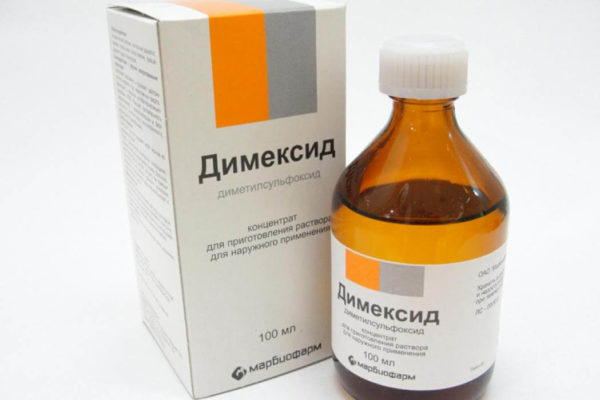
How to remove foam from a wooden door
- Soft abrasives. Use improvised products with fine abrasiveness - baking soda and soda ash, fine salt and a household sponge. Apply baking soda or salt to a damp cloth and rub the stained area thoroughly.
- Mechanical cleaning. Use a plastic scraper when the blade is unrefined. After cleaning, use polish to remove scratches.
How to remove fresh foam
To remove a fresh stain, roll the foam from the edges towards the center with a wooden or plastic spatula. An iron tool will damage the floor surface. Thoroughly clean the dirt using a good cleaning agent. Then the place is treated with any fat-containing substance:
- wax;
- cream;
- butter;
- polish.
No matter how hard you try, it is impossible to completely clean the cured polyurethane foam from the surface. Since it has the property of penetrating into any material at the molecular level.
You can remove fresh assembly sealant, wallpaper glue and PVA with water and salt. The main part is cut off, and on top of the remnants we put a generously moistened rag so that they become sour. After the foam has dried, remove it from the laminate or linoleum with a sponge. But when using this method, you should be careful, as this flooring does not like moisture very much. Therefore, it is not recommended to soak for more than five minutes, as the coating may swell and begin to bulge.
Floor coverings
The falling of polyurethane foam on the floor is the most frequent occurrence in the repair. It is not easy to wipe away marks on floor coverings. The agent that will be used for this will depend on the type of floor material.
Coating and cleaning method:
- Linoleum. This material does not absorb foam, so the removal process is not time-consuming. You just need to wait until it dries, cut off the base of the hardened piece, and then dissolve the remnants with Dimexide, which must be applied to the desired area for 15 minutes. It is recommended to wash the area with soapy water after cleaning.
- Parquet. The cleaning process is the same as for linoleum. The only difference is that the parquet floor can also be washed with fresh foam. To do this, it is enough to clean the area with ordinary cleaning agents.
- Carpets. The substance adheres tightly to the villi, which will have to wait for it to harden. When it dries, you need to throw a damp rag on top. After a few hours, the cloth can be washed, and traces of foam can be removed with a brush.
- Laminate. Removal from the laminate is quick and easy. As in the case of linoleum, you need to wait until it dries, and then process it with Dimexide and after a while wash off all the remnants with a sponge.
- Wood. Foam can seep into wood surfaces, making the situation much more difficult. However, Dimexide also has such properties, due to which it easily removes the remains of any substances. You need to apply it to the problem area for one hour, and then wipe it off with a sponge or brush and wash.
We remove polyurethane foam from various kinds of coatings - video:
After completing all cleaning procedures, the floor should be thoroughly washed and allowed to dry.
How to wipe the polyurethane foam from the skin
When there are no solvents nearby, or contamination, it was not immediately detected.It is better to wait until the product is completely dry (usually 45 minutes - an hour), and remove the contamination mechanically.
Mechanical removal method
Also, under no circumstances, it is not necessary to rub the polyurethane foam sealant on the skin with a dry cloth, so you will only aggravate the situation. Firstly, increase the areas of contamination, and secondly, the foam will be more difficult to pick up for scraping.
Hardened polyurethane foam can only be removed mechanically: with a pumice stone, a brush, a metal nail file (in small areas), nails, fine-grain sandpaper, etc. To facilitate the task, you can first steam the skin of your hands (30 minutes) in hot water. From the steamed top layer of the skin, the sealant is easier to remove.
Also, it is worth trying to remove the foam with heated sunflower oil (heat it, no more than 30-40 degrees, in order to avoid burns). For this purpose, you can apply a fat baby cream, lard or fat. If the foam is not rubbed off with oil alone. Sprinkle detergent on top of the oil and scrub with a brush. In this case, the oily film on the skin will help soften the rough brushing effect.
Also, to remove the sealant from the skin, at home, use ordinary salt. To do this, in a container with warm water, dilute a little table salt, put your hands in the resulting solution and keep it in water for a while
It is important not to overdo it with salt, as a strong concentrate will only strengthen the pollution, and not contribute to its washing. Clean off dirt with smooth strokes
If the dirt is light, soak your hands in a soapy solution, and when the skin is well wet, scrub the dirt with a brush or washcloth. You can apply a scrub after the soap solution, it will help wipe off the adhering traces of the foam mass.
The foam that gets on the nails is scraped off only with something hard, you will not be able to wash it off the nails.
After carrying out all the manipulations that cleanse and wash the polyurethane foam from your hands, be sure to treat the skin with regenerating (restoring) agents: aloe juice, baby cream, etc., because it has been negatively affected by very aggressive agents.
Chemicals for removing polyurethane foam
Often, to remove foam from the skin, it is advised to use Dimethylsulfoxide, aka "Dimexide". It is sold in a pharmacy, at a very affordable price, without a doctor's prescription, and it contains a component that destructs the composition of the foam. But, this drug is very quickly absorbed by the skin, enters the bloodstream, and can cause a number of side effects on the body. Among them are dizziness, intestinal upset, bronchospasm, insomnia, dermatitis, etc. In this case, you need to weigh well the pros and cons of using such a drug, because health is much more important.
 You can, of course, not injure the skin, and not remove the dried sealant from your hands, after a few days it will fall off by itself with dead epithelial cells, but this is hardly convenient. Therefore, the tips collected in this article are designed to help you cope with the problem, and clear your hands of polyurethane foam. But in the future, be sure to put on tight leather gloves and special clothing (or one that, in which case, you would not mind throwing away) before using such an indispensable assembly sealant, cover your skin and hair as much as possible. A hat, gloves, tight clothing covering the whole body should become an integral part of your clothing. So you will prevent trouble and save a lot of time, because the sealant is not only difficult to clean, it is toxic, and can cause an allergic reaction throughout the body.
You can, of course, not injure the skin, and not remove the dried sealant from your hands, after a few days it will fall off by itself with dead epithelial cells, but this is hardly convenient. Therefore, the tips collected in this article are designed to help you cope with the problem, and clear your hands of polyurethane foam. But in the future, be sure to put on tight leather gloves and special clothing (or one that, in which case, you would not mind throwing away) before using such an indispensable assembly sealant, cover your skin and hair as much as possible. A hat, gloves, tight clothing covering the whole body should become an integral part of your clothing. So you will prevent trouble and save a lot of time, because the sealant is not only difficult to clean, it is toxic, and can cause an allergic reaction throughout the body.
How to avoid skin contact
Even at the stage of buying all the necessary materials for the repair, you must definitely stock up on a special tool that will quickly and effectively wash off the polyurethane foam from any surfaces.
In addition, when working with a sealant, you should not forget about personal protective equipment. First of all, you must protect your hands. The easiest way to do this is with gloves. Depending on your personal preference, these can be thick rubber gloves, cotton gloves, or even medical latex gloves.
Cover your hair with a scarf, cap or hat, depending on the season and whether you will be outdoors or indoors while working with the foam.
Clothing should be old and unnecessary, while covering hands and feet as much as possible to prevent the sealant from getting on the skin. It's much easier to clean the lather from your clothes than trying to scrub it off your skin. As a last resort, if the clothes are heavily soiled, they can be thrown away. But if foam gets on the skin, especially a large amount, you will have to tinker a lot longer.
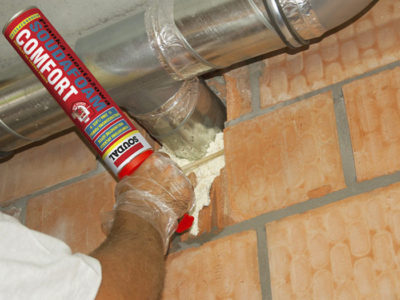
Features of pollution
A person who does not understand repair issues and for the first time took a sealant for work is likely to fall into his hands. Working with polyurethane foam without gloves and at the same time not getting dirty is very difficult
Even if a person has taken all precautions, then there is a possibility that a couple of drops of sealant will end up on uncovered areas of the skin
Polyurethane foam is a type of sealant that contains polyurethane. It is produced in the form of an aerosol and is used in almost every type of construction and repair work. When cured, such a composition becomes solid polyurethane foam. The container contains a mixture consisting of a liquid prepolymer and a propellant gas. Due to the presence of this gas in it, the foam comes out from there. Solidification occurs through interaction with moisture both on the surface and contained in the air of the room. Accordingly, the drier the air in the room, the longer the composition will harden. You can speed up this process by spraying the foam with water from a spray bottle.
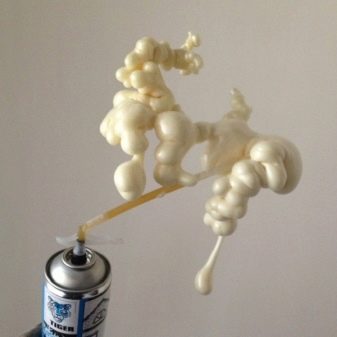

Typically, hard foam is almost white with a slight tint of yellow. However, in case of exposure to ultraviolet rays, it turns yellow and loses its bonding properties. The weight of the composition is very small. In addition, the assembly sealant is not moisture resistant. The adhesive properties are very high - the composition does not "work" on Teflon, polyethylene, silicone, polypropylene.
When working with polyurethane foam, it is imperative to take into account its properties such as primary and secondary expansion. Primary is the expansion that occurs to the sealant immediately after it leaves the container. Secondary - until the composition hardens completely. It can vary from 15 to 100%. In the case when the percentage of secondary expansion is large, it is necessary to very sparingly apply the foam to those places where there is a possibility of its strong swelling and, due to this, deformation of the surface.

Gaps and cracks are filled with mounting foam for the purpose of heat, hydro and sound insulation. In addition, pieces of building materials are held together with it. Previously, cement or tow was used for these purposes, but this took a lot of time and effort, while the quality of adhesion of materials to each other sometimes left much to be desired.
Nowadays, when a large number of new, natural and artificial materials have appeared, a better quality, faster and easier-to-use tool is required to bond them together. To work with polyurethane foam, no preparation is needed, and there is also no need to use additional devices and tools - it is enough to purchase a cylinder, study the instructions for using the material and you can start performing construction or repair work.
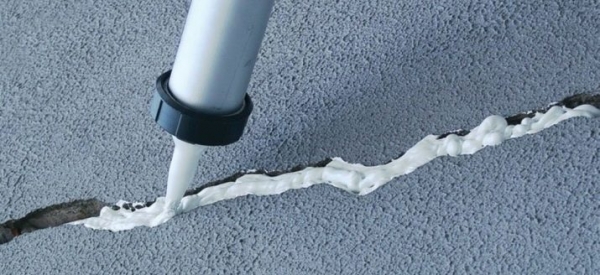
In order for the foam to solidify correctly and not lose its properties, you need to follow the rules for working with it:
- The temperature should be in the range from +5 to +30 C.
- Coincidence of the primary and secondary expansion of the foam with the size of the hole to be sealed.If it is less than 1 cm, then it is better to use a putty.
- Before starting work, the place where they will be produced is sprayed with water - this way the foam will harden better.
- Shaking the container should be carried out for at least a minute so that the entire contents turn into a homogeneous mass and mix well.
- After applying the foam, spray it again with water.
- Add sealant if it seems that little has been applied, you need not earlier than after half an hour.
Of course, when working with this type of hermetic mixture, it is best to use gloves made of dense rubber and wear work clothes that you do not mind getting dirty and throwing away in case of an abnormal situation. Even then, there is a chance that the drops of the sealant will get on the skin. In this case, the foam blocks the air, which can cause serious allergic reactions. Therefore, it must be washed quickly and painlessly, without damaging the skin.
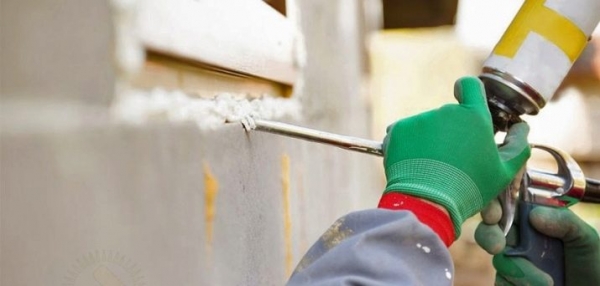
Some experts recommend lubricating the skin with vegetable oil or petroleum jelly to avoid sticking of the sealant to the hands. However, this is not very convenient. In addition, at the end of the work, it is also problematic to wash everything that is touched with fat palms. Therefore, this advice is not widespread among those who know a little about repair and construction work.

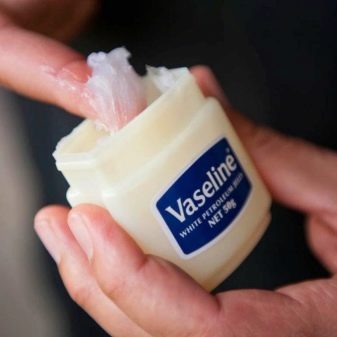
Finally
Before removing the sealant, you should carefully consider your actions. So that later you do not have to install a new floor covering. When cleaning, use only special cleaners. Removing polyurethane foam from the laminate is difficult, but possible. The main thing is to act carefully so as not to damage the floor during the cleaning process. One of the handy tools that can be used safely for coating at home is vodka. With its help, not only a trace of foam is removed, but also from an adhesive tape.
In order to reduce the ingress of substances onto the floor during repairs, which are then difficult to remove from it, you need to cover the floor with cardboard, film or other improvised material before starting work. By covering the floor, you prevent the possibility of sealant getting on it. It is much better to prevent a difficult situation from arising than to eliminate it later. When carrying out repairs, act as carefully as possible so that later you do not have to devote too much time to cleaning.
Some more useful information can be found in the video below:

